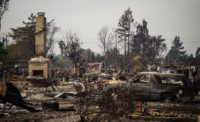On the morning of Nov. 8, flaming pine needles rained down on the homes of Paradise, Calif., blown from the Camp Fire, still 2.5 miles away. The embers set fire to roofs, attics, landscaping, decks and any other fuel in their path.
Within four hours, most of the town’s homes and buildings were in ashes. Surrounding communities, including Magalia, Pugla and Concow, where the fire hit first in the early morning, were decimated. The fire killed 85 people and destroyed 18,800 structures in Butte County, 14,000 of which were in Paradise. The town’s water system was irreparably damaged as meters and plastic pipes heated and melted, releasing benzene into the water and allowing in deadly bacteria.
It was the worst fire in California history—topping the previous No. 1, the 2017 Tubbs Fire that killed 22 people and destroyed 5,800 structures in Napa and Sonoma counties.
Today, six months after the Camp Fire, Paradise looks much as it did just days after the fire roared through. Most debris has yet to be cleared and little is recognizable except standing fireplaces and the occasional concrete wall. In the town’s 18 sq miles, only about 1,300 structures are still standing.
This story, which you can read in full on ENR.com, is the first chapter of Hazards Ahead, a series about resilience from RECORD’s sister publication.





